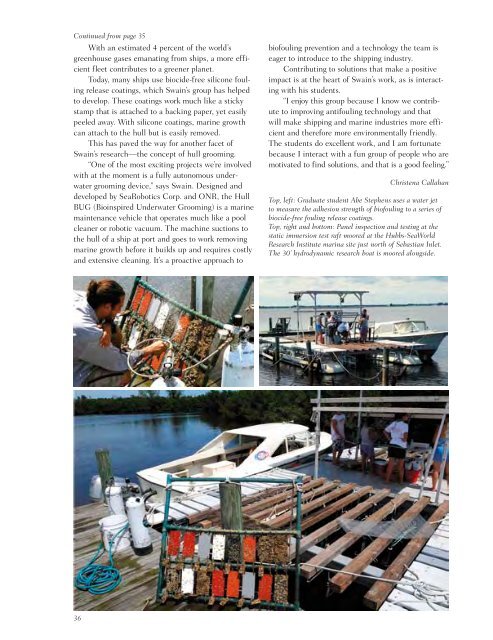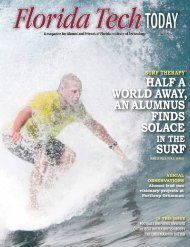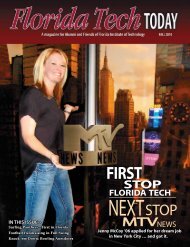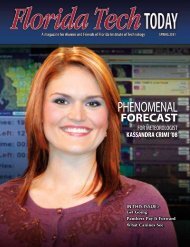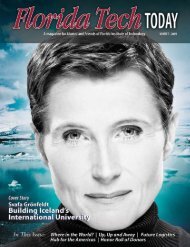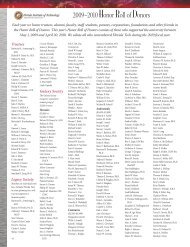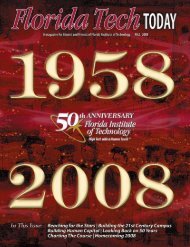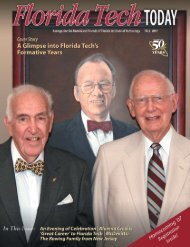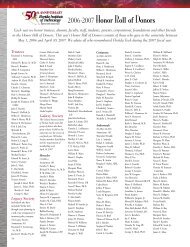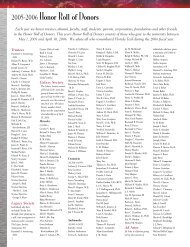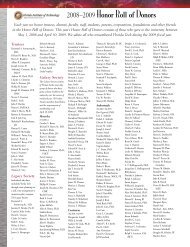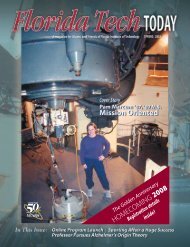Fall 2009 - Florida Tech Today - Florida Institute of Technology
Fall 2009 - Florida Tech Today - Florida Institute of Technology
Fall 2009 - Florida Tech Today - Florida Institute of Technology
Create successful ePaper yourself
Turn your PDF publications into a flip-book with our unique Google optimized e-Paper software.
Continued from page 35<br />
With an estimated 4 percent <strong>of</strong> the world’s<br />
greenhouse gases emanating from ships, a more efficient<br />
fleet contributes to a greener planet.<br />
<strong>Today</strong>, many ships use biocide-free silicone fouling<br />
release coatings, which Swain’s group has helped<br />
to develop. These coatings work much like a sticky<br />
stamp that is attached to a backing paper, yet easily<br />
peeled away. With silicone coatings, marine growth<br />
can attach to the hull but is easily removed.<br />
This has paved the way for another facet <strong>of</strong><br />
Swain’s research—the concept <strong>of</strong> hull grooming.<br />
“One <strong>of</strong> the most exciting projects we’re involved<br />
with at the moment is a fully autonomous underwater<br />
grooming device,” says Swain. Designed and<br />
developed by SeaRobotics Corp. and ONR, the Hull<br />
BUG (Bioinspired Underwater Grooming) is a marine<br />
maintenance vehicle that operates much like a pool<br />
cleaner or robotic vacuum. The machine suctions to<br />
the hull <strong>of</strong> a ship at port and goes to work removing<br />
marine growth before it builds up and requires costly<br />
and extensive cleaning. It’s a proactive approach to<br />
36<br />
bi<strong>of</strong>ouling prevention and a technology the team is<br />
eager to introduce to the shipping industry.<br />
Contributing to solutions that make a positive<br />
impact is at the heart <strong>of</strong> Swain’s work, as is interacting<br />
with his students.<br />
“I enjoy this group because I know we contribute<br />
to improving antifouling technology and that<br />
will make shipping and marine industries more efficient<br />
and therefore more environmentally friendly.<br />
The students do excellent work, and I am fortunate<br />
because I interact with a fun group <strong>of</strong> people who are<br />
motivated to find solutions, and that is a good feeling.”<br />
Christena Callahan<br />
Top, left: Graduate student Abe Stephens uses a water jet<br />
to measure the adhesion strength <strong>of</strong> bi<strong>of</strong>ouling to a series <strong>of</strong><br />
biocide-free fouling release coatings.<br />
Top, right and bottom: Panel inspection and testing at the<br />
static immersion test raft moored at the Hubbs-SeaWorld<br />
Research <strong>Institute</strong> marina site just north <strong>of</strong> Sebastian Inlet.<br />
The 30’ hydrodynamic research boat is moored alongside.


